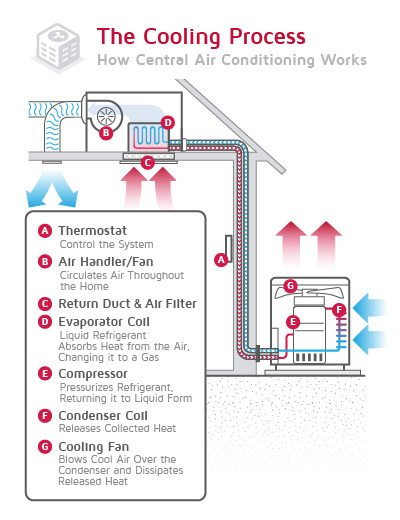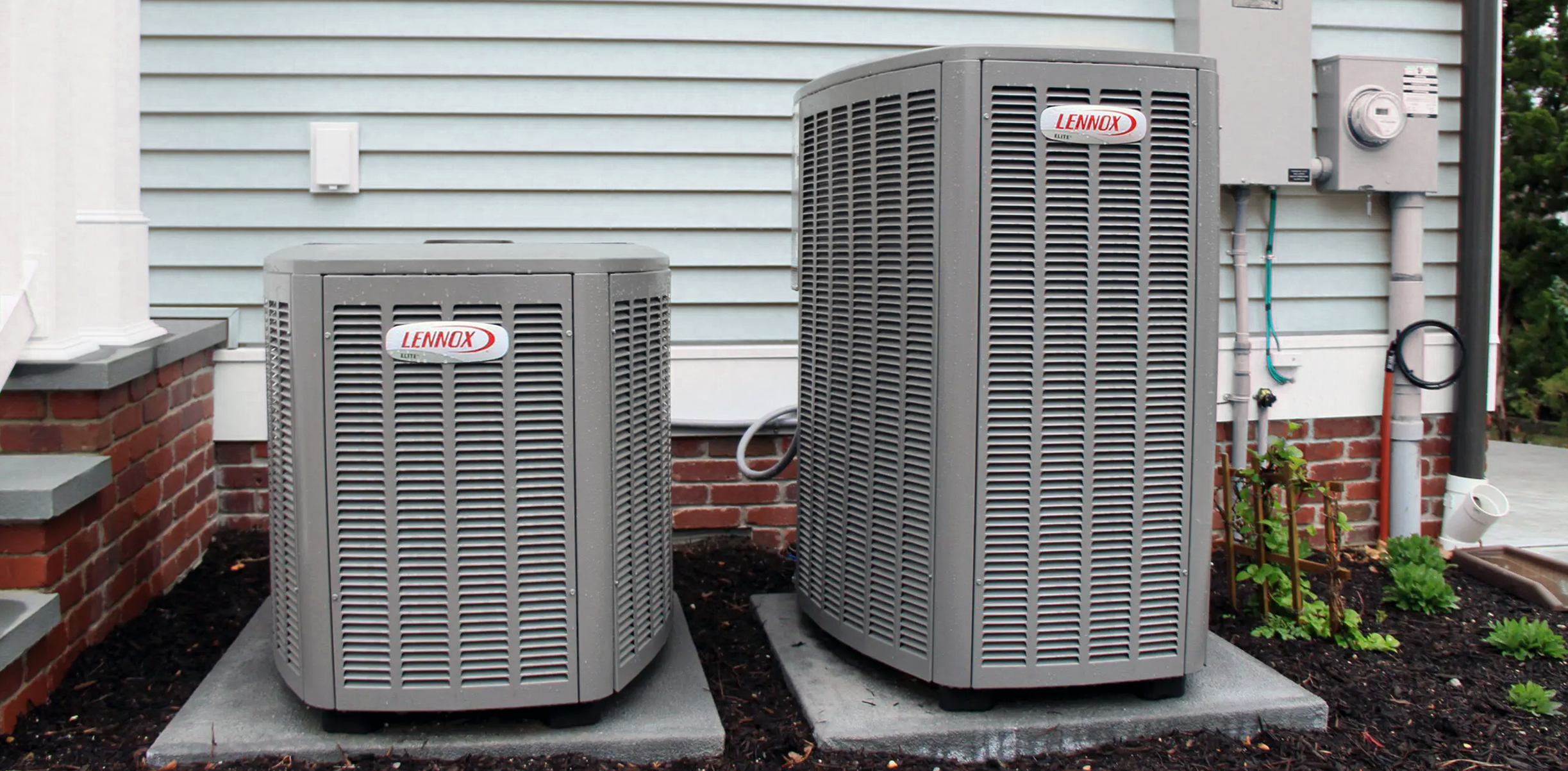What is a Central Air Conditioning System?
Developed in the 1960s, central air conditioning or central AC is the most common type of whole-home HVAC system used in the United States today. A central AC system’s job is to cool air in a central location and distribute it evenly throughout a home or other multi-room space. This centralization eliminates the complications of cooling each space separately while maximizing efficiency and comfort.
Central AC units can cool an entire home and are designed to regulate the cooled air in different ways, while AC units like windows units are less powerful and only cool a single room. This type of AC unit is not as efficient as other types, but it works for small spaces and is the most affordable and easiest to install. A central air system is more expensive but can save you a lot of money in the long run.
Understanding Central Air Conditioning Systems
Controlled by an indoor thermostat, a central air conditioning system uses a chemical refrigerant process to cool a home. Copper coils, one located indoors and one outdoors alternate evaporating and condensing the refrigerant. The indoor evaporation part of this process collects heat from inside the home and the outdoor condensation process releases it.
During this cycle, the air handler pulls warm air from inside the home and passes it over the indoor coil, cooling it. This cool air is then routed throughout the home by way of a network of ducts and vents.

Components of a Central Air Conditioner
To get a better understanding of how your air is cooled, it's helpful to know about the components that make up the air conditioning system. The most common central air conditioning system is a two-part or split system that includes:
OUTDOOR EQUIPMENT
Air Conditioner or Heat Pump: Includes the condenser coil, compressor, electrical components and a fan.INDOOR EQUIPMENT
Evaporator Coil: Usually installed on top of the gas furnace or within the air handler.SUPPORT COMPONENTS
Thermostat: Used to set desired temperatures and control the system.
Ductwork: A network of insulated tubes used to route air within the home.
Refrigeration Lines: Copper pipes used to connect the indoor and outdoor equipment.
Refrigerant: Circulated by way of the refrigeration lines through the indoor and outdoor units.
Types of Central Air Conditioners
There are two main types of central air conditioner systems—split systems and packaged systems. A split system uses a combination of indoor and outdoor equipment to minimize noise and maximize efficiency, while a packaged system contains all of these components in a single, space-saving unit.
Split System Air Conditioner
This type of central AC system is the most common. It consists of an indoor unit, such as a furnace or air handler coupled with an evaporator coil, and an outdoor unit housing the condenser coil and compressor. Within the split system type, there are a range of products varying in efficiency and up-front investment.
- Basic single-stage systems: Offers lower up-front cost but also lower efficiency ratings.
- Mid-tier single or two-stage systems: Typically a good balance between cost and efficiency.
- Premium two-stage systems: Higher cost point, but the quietest, most energy-efficient option.
Properly selected and installed, a split system air conditioner will deliver consistency and reliability, providing balanced temperature control for an entire home for many years.
Packaged Systems or Packaged Units
A packaged system is an all-in-one solution where both the indoor and outdoor components are housed in a single unit. Packaged units are designed for specific applications such as areas with limited space or instances where rooftop installation is preferred. The package system utilizes the same refrigerant cycle as the split system, with all processes happening in a single, contained space. Airflow enters and exits the system directly by way of primary ducts connecting the unit directly to the home. Once inside, the air is directed to the various spaces by the same style of duct network used by a split system.
Single-Stage vs. Two-Stage Air Conditioners
When equipping a split system, you can also choose from single-stage or two-stage air conditioner units. The biggest difference between the two is that a two-stage air conditioner has a compressor that can operate at two different speeds. A one-stage compressor is either on at 100% or entirely off. On the other hand, a two-stage compressor has a 100% setting and another setting that is around 70% capacity, depending on the brand and model.
You're probably familiar with the traditional one-stage model and how it turns on and off depending on the temperature. For instance, if you set your thermostat to 72 degrees, the AC might let the home get to 73 before kicking on, then cool it to 72 or 71, and the cycle repeats.
With a two-stage compressor, the system can work less hard when the temperature is close to the set point, using less energy and reducing the need to turn on and off at 100% capacity as often.
Selecting or Upgrading Your Central Air Conditioner
There are many factors to consider when choosing to install or upgrade a central air conditioning system.
- Location and Climate: The primary factor in selecting a system that’s right for your home is the region where you live. If you live in a moderate zone where summers and winters are mild, you’ll require a very different system than a homeowner in an area with extreme summer temperatures or long winters.
- Home Size and Design: Regardless of weather, the size of the area you’ll be cooling will determine the capacity of the AC unit you’ll need. This capacity is measured in BTUs (British Thermal Units). A BTU is a measurement of the amount of heat it takes to raise the temperature of one pound of liquid water by 1º Fahrenheit. While that may not sound directly related to cooling a home, the BTUs measurement is used in HVAC to calculate how much heat an air conditioner can remove from the air.
The design of your home can play a role as well—especially if you have a multi-story home. Two- or three-story homes require different calculations to determine the appropriate system for the job. Balancing air flow and temperatures across multiple stories can require specific techniques and equipment when designing and installing ductwork and airflow.
- Efficiency and Environmental Preferences: Determining the efficiency level that’s right for you involves balancing the up-front investment and the ongoing cost of ownership. The higher the efficiency ratings or SEER/SEER2 ratings of the equipment you choose, the higher your initial investment is likely to be. However, higher SEER ratings also translate to lower energy bills which also means reduced environmental impact. Weigh your purchase budget against the expected cost of ownership and environmental impact to determine what you’re comfortable with. Remember financing opportunities can play a big role in making this part of your decision.
- Your Comfort Preferences: Of course, you should always take your family’s comfort into account. Understanding comfort requirements such as ideal temperatures or zoning for different temperatures throughout your home can help ensure you select a system that meets all your needs.
The Benefits of Upgrading to a Newer, More Efficient System
Due to recent changes in the regulations around refrigerant use, HVAC equipment manufacturers have updated their equipment offerings for 2024. These new offerings use more environmentally friendly, low GWP (Global Warming Potential) refrigerants. This means upgrading will not only improve your system’s overall efficiency, but it will also get you the latest in environmentally friendly technology and compatibility—ensuring easy maintenance and future system modifications over the life of your system.
If you’re considering upgrading your central air conditioner or looking to purchase a new central A/C system, we encourage you to reach out to a local Lennox pro. They can walk you through the selection process to help you determine which system or upgrades will be most beneficial for you and your home—helping you make the best decisions for your family from purchase to perfect air.




